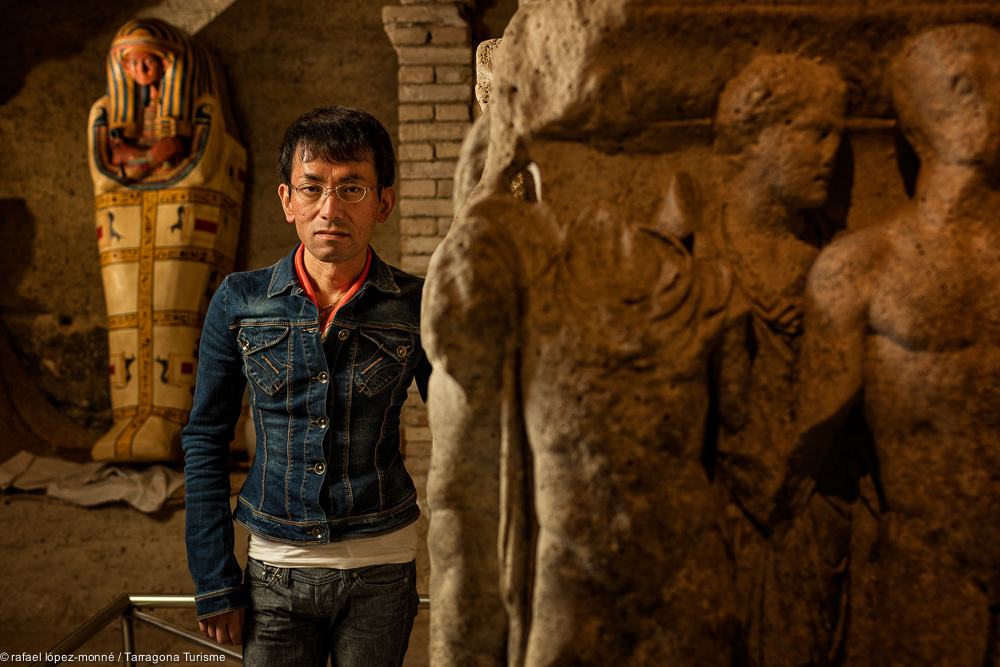
Doctor Katsuyuki Takenaka, professor of Human Geography at the Department of Foreign Studies at Aichi University, has flown over 13.000km in order to get from Japan to Tarragona and study the interaction model existing between citizens and historical heritage set by Tarraco Viva. Takenaka, who is undertaking an academic research paper, found “universal values represented in a very creative way” in the historical dissemination festival of Tarragona and was surprised about, not just the high level of commitment towards scientific rigour taken by the organisation, but also towards seduction and public engagement. “This is a model that should be taken into consideration in other parts of the world that have ever thought about revitalizing patrimony as collective memory and identity spaces”, says Takenaka.
Katsuyuki, Katsu among his friends, got his specialization by doing some research about the interaction existing between citizens and the physical environment they inhabit. Some years ago, he undertook a study in the Japanese embassy about interior migration in Spain, and it was then that he got to discover Catalonia, a territory he has visited a number of times ever since, specially the Tarragona area, to which he got hooked seven years ago. Experiences and lessons learnt on his trips, he says, have improved his scientific knowledge and allowed him to provide other cultural perspectives rather than the Japanese.
Katsu is not the typical Japanese tourist paying tribute to Gaudi’s brilliance as part of a group. He carries a camera, yes, but he travels alone, learns by himself, and speaks a faultless Catalan, consolidated by sticking his nose in Geography books in Japan and perfected during a stay in Vilafranca. This is not his first time in Tarragona and, if Tarraco Viva wasn’t held during university’s busiest time of the year, he’d manage to come back in future editions. “Tarragona is a city open to contrasts, a node with high capacity of integration. It was built throughout the centuries thanks to cultural fusion, with the harbour as a leverage effect in trade, and working as a meeting point for people from all over the Mediterranean area. Even today, there are many people that were born abroad, but still, the level of cohabitation and social balance is very high”, he states.
He is currently working on a study that will arise different action proposals to restore the use and citizen appreciation of Nagoya’s city canal, which was built a hundred years ago as an industrial transport of goods, but was closed some decades ago.
Katsuyuki got many new ideas in Tarragona. “I incorporate ideas about how people see their city, and how the different patrimonial spaces interact, not just with the personality of every individual, but also with how these end up creating a common identity”, explains. According to this academician, whose research project is sponsored by the Ministry of Culture of Japan, “the only way to get an economic advantage from heritage is by making it valuable to those that live around it. Not doing it would lead to trivialisation and loss of interest”.
By means of historical dissemination –by publicly reinterpreting the events and lifestyle of the Romans in emblematic locations of the city– Tarraco Viva intends Heritage to become a driver for social wealth and cultural industry. The target is to complete a large virtuous circle: to generate new resources with this event, so that they can then be allocated to preserve monuments and promote Historical research and dissemination. “Catalan and Japanese people resemble in a way: we both love a job well done; and Tarraco Viva proves that point”, he ends.
Text: Oriol Margalef (@OhMargalef a Twitter).
Picture: Rafael López-Monné (@lopezmonne on Twitter)
Translation: Artur Santos (@artur_1983 on Twitter)



